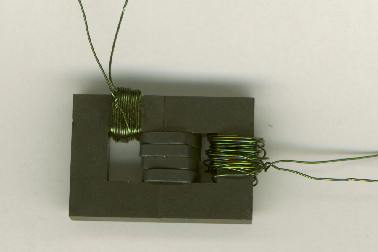My MEG Picture Gallery
I've started tinkering with MEG parts, just fooling around, thinking, and doing a few experiments. I haven't gotten very far yet but I thought that I would share the few things I've done and learned with everyone else out there who may be thinking about working on this stuff too.
I bought a couple of ferrite cores from Radio Shack… they are pretty small (about 1" x 1.5"). In fact, they are so small that you probably don't want to go this route - I was anxious to get my hands on something to begin experimenting with, and so I bought these (about $8). See picture (below) of the package with one core left in it.
Here's one of the ferrite "C"s - i.e. half of the core. The ends are ground flat and smooth and so they fit tightly against the other half of the core with no air gap.
Be careful, they are fragile! L
Here is a drive coil wound on one of the "C"s, about 30 turns.
I bought some NIB magnets from Industrial Liquidators, a local surplus place. I scored them in the middle, put them in a vise, and snapped them into halves. This picture shows two whole magnets and two halves. They are about 1/8" thick.
Here is a stack of four magnet halves. They are magnetized through the narrow dimension, and so they stack nicely with the magnetic flux emanating from the top and bottom of the stack. I sanded the mating faces a little at a time until the stack was just thick enough to fit within the jaws of the "C" cores without breaking them.
Here is everything assembled - note that the magnetic flux holds the "C" core halves together nicely without the need for adhesives. My first experiment was to see if I could "switch off" the magnetic flux in the control winding side of the core. I hung a couple of paperclips on the flux leaking from the vertical edges of the core and applied some power to the control coil from a bench power supply. I was able to get the paperclip on the left half of the core to drop off; however, the coil heated excessively. I suspect that I need to use more turns of wire to generate a strong enough field without cooking the coil.

I have more questions than answers at this point. For example, I don't know how to figure out whether or not these particular permanent magnets are saturating the core's capacity to channel magnetic flux. I don't know how to really determine whether or when the control coil has maximally shunted the magnetic flux to the other half of the core.
It seems to me that I ought to be able to empirically determine the size of the control winding I need by finding a number of turns with which I can shunt the magnetic flux without the coil getting to hot. The next step would be looking at the waveform across the coil as power is applied, and thus determining the time constant (i.e. how long I need to apply power to the control coil to result in a fully shunted flux. Next, I think I should be able to put a switched load (see "
Some Speculations on MEG Switching") on the output coil. Starting from a "steady state" of power applied continuously to the control coil (i.e. all the flux in the right half of the core), I can then connect the load to the coil. Finally I should be able to capture the output on a scope, triggered when I manually remove power from the input coil.As a result of these experiments, I should be able to determine whether or not power out from two identical output coils in a single cycle/pulse will be greater than the input pulse needed to switch the flux. I realize that this speculation of how to make this work does not reflect much of Mr. Bearden's descriptions of what is happening in the MEG. Much of my line of reasoning is based on papers and letters from David Squires and Jon Flickenger and others who have been thinking and experimenting before me.
Stay tuned for further developments.
![]()
Back to my MEG page | Some Speculations on MEG Switching | JLN's MEG animation